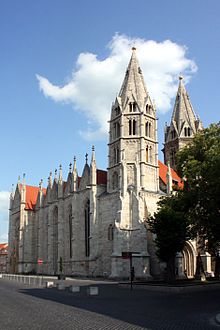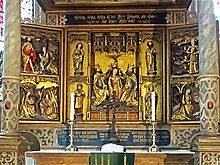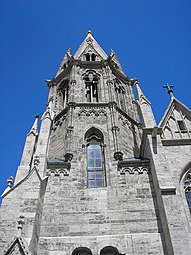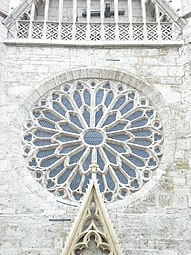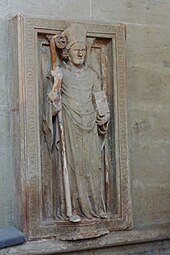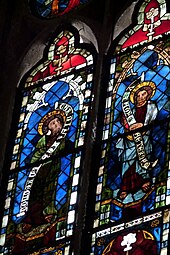Divi Blasii Church
The Divi-Blasii-Kirche is a three-aisled, cross-shaped hall church on the lower market of the city of Mühlhausen in Thuringia . The shop facade on the north side, lavishly designed with tracery , pinnacles and a wheeled window, is on an old trade route.
history
The Teutonic Order began building this Gothic church around 1276. Previous structures date back to the early 12th century.
In 1556 the Teutonic Order left the church to an Evangelical Lutheran congregation. Around 1600 the Latin name sanctus Blasius was replaced by divus Blasius .
From July 1707 to July 1708, Johann Sebastian Bach was the organist here. For the change of council he composed the festive cantata Gott ist mein König in February 1708 , which is the only print from this period that has survived.
With the introduction of the Prussian Union Agenda of 1817, the church became part of the Prussian Union Churches (EUK). Since secularization it has been the central church of the evangelical parish of Mühlhausen and a venue for concerts and art exhibitions.
architecture
In the north transept there is a tracery rose that is slightly smaller than that of Notre-Dame in Paris. Under the tracery rose there is an eyelash portal on the north outside . Maßwerkrose, Wimpergportal and choir polygon - here especially the low base level, the high windows and the roof gable - can significantly influence northern French cathedrals recognize. The nave and the choir polygon, built around 1276/82, form a ribbed vault . Two keystones in the choir are adorned with an eagle and a lion, both signs of the virtues of Christ.
On the west side there are two octagonal, 42 m high stone towers, which come from a previous building from around 1245/65. The tower bases are characterized by Romanesque style elements. In the south-west tower there is a bell from 1281. The towers are similar to the two small towers of the neighboring Marienkirche. Both have gone out of balance due to insufficient foundations. The church is accessed today through the west entrance. Above the west portal is a tympanum depicting the crucifixion of Christ.
Furnishing
Inside the church there are significant tombstones from the 13th and 14th centuries, a late Gothic pulpit, epitaphs from the Renaissance period, an octagonal baptismal font from 1596 and a Luther statue from 1903. Between 1543 and 1548 the convertible altars in the interior were opened during the iconoclasm destroyed. The high altar in the choir polygon was largely preserved and shows the life of the Virgin Mary and saints. The choir and crossing are separated by a forged lattice from the Baroque period from around 1640. The choir houses a. a. also a portrait of the former Mühlhausen superintendent and hymn poet Ludwig Helmbold . There are grave slabs of clergy dignitaries on the choir walls.
The choir windows date from 1310/1330 and depict John the Baptist and St. Blaise . The seven old choir windows were restored by the Linnemann workshop in Frankfurt around 1900, and Alexander Linnemann redesigned six additional windows with figurative representations. Documents on this can be found in the Linnemann archive.
The Gothic arched windows of the Divi Blasii Church are said to have served as a model for the architect Johann August Röbling ( John August Roebling ) , who came from Mühlhausen and who emigrated to the USA, when designing the towers of the Brooklyn Bridge between the New York districts of Manhattan and Brooklyn .
organ
The Schuke organ, originally inaugurated in 1959 and after a general overhaul on September 14, 2008, is located on the west gallery . Albert Schweitzer, as organist and Bach connoisseur, contributed to its planning; A disposition specially designed for this church by Johann Sebastian Bach served as the basis . Bach had the arrangement of the organ of that time changed according to his ideas. This makes it one of the few organs in the world that were built according to a plan made by Bach. The instrument has three manuals and 42 stops . Few registers were added to Bach's underlying draft so that more modern organ literature with its timbres can also be played authentically.
|
|
|
|
|||||||||||||||||||||||||||||||||||||||||||||||||||||||||||||||||||||||||||||||||||||||||||||||||||||||||||||||||||||||||||||||||||||||||||||||||||||||||||||||||||||||||||||||||||||||||||||
- Coupling : II / I, III / I, I / P, II / P
- Cymbelstern
Johann Sebastian Bach was the organist at the Divi Blasii Church in 1707/08. On the day of St. Blasius , February 3rd, the council election took place every year. The following day the blessing for the new council was requested in a festive service. Bach's cantata God is my King was written for this occasion ; on February 4, 1708 it was premiered in Divi Blasii.
The Bach monument created by the sculptor Klaus Friedrich Messerschmidt and unveiled in 2009 next to his place of work Divi Blasii shows the young Bach standing next to a monument base.
Tracery rose in the transept
Tombstone of Christian von Mühlhausen (died 1295)
Bells and carved bell drawings
Three valuable medieval large bells hang in the two west towers. The big bell in the north tower was cast in 1345. It weighs around 5½ tons and, like the smaller measuring bell from 1448, is adorned with rare, art-historically significant carved bell drawings . The Sunday bell from 1281 is considered the oldest dated bell in Thuringia.
Individual evidence
- ↑ Johann Sebastian Bach - A Chronology. Bach Archive Leipzig, accessed on July 8, 2018 .
- ^ Rainer Nolden (2008): The eighth wonder of the world. epoc 3: 12-19.
- ↑ Text booklet for the CD: "Matthias Eisenberg at the Christoph-Treutmann-Organ Grauhof", recording from September 1993, label: ram, CD-No. 59309, page 7
- ↑ http://messerschmidt-bildhauer.de/Denkmale/Bach.jpg
- ↑ Claus Peter: The bells of the city of Mühlhausen / Thuringia, in: Thuringian State Office for Monument Preservation (ed.), Workbook of the Thuringian State Office for Monument Preservation, New Series 10, Erfurt 2002.
- ↑ Ingrid Schulze (from page 31 as well as 47–48) in her book Incised Drawings by Laymen - Drawings by Medieval Sculptors and Painters? Figural bell scratch drawings from the late 13th century to around 1500 in central and northern Germany. Leipzig 2006, ISBN 978-3-939404-95-8 .
literature
- Jakob Altersberger: Investigations into the church history of Mühlhausen in the Middle Ages . Thesis. University of Vienna, 2013, Parish Church St. Blasii, p. 47–51 ( full text [PDF; 21.8 MB ; accessed on June 25, 2018]).
- Ernst Badstübner : The old Mühlhausen. Art history of a medieval city . Koehler & Amelang, Leipzig 1989, ISBN 3-7338-0055-9 .
- Diana Joneitis, Susanne Scheibner (Red.): The stained glass of the Divi Blasii Church in Mühlhausen, Thuringia . Reinhold, Altenburg 2011, ISBN 978-3-937940-77-9 .
- Bernd Wedemeyer: The Blasius Church in Mühlhausen and the Thuringian sacred architecture between 1270 and 1350 . 2 volumes. Wasmuth, Berlin 1997, ISBN 3-00-000150-6 .
See also
Web links
- Parish office Mühlhausen Divi Blasii-St. Marien. Evangelical church district Mühlhausen
Coordinates: 51 ° 12 ′ 25.8 ″ N , 10 ° 27 ′ 29.8 ″ E
